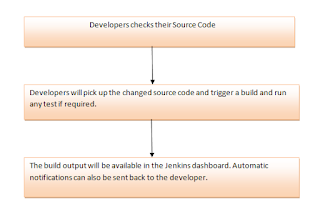Here In this tutorial, we will learn What is Jenkins and How to Perform Continuous Integration with it.
What is Jenkins:-
It is a powerful application that allows continuous integration and continuous delivery of projects.
Jenkins will be installed on a server where the central build will take place.
Along with Jenkins, one might also see the associate of Hudson.
What is Continuous Integration:-
When developers, developed the code so they require to integrate the code into a shared repository at regular intervals. The concept of integrating the code in regular intervals to remove the problem of finding the later occurrence of the issue in the build lifecycle is called continuous integration.
Key Points:
Since after every commit to the source code an auto build is triggered and then it is automatically deployed on the test server.
If the test results show that there is a bug in the code then the developers only have to check the last commit made to the source code.
This also increases the frequency of new software releases.
The concerned teams are always provided with relevant feedback.

